Cost Accounting Report: Gibson Fabricators Corporation
VerifiedAdded on 2022/09/18
|8
|1080
|26
Report
AI Summary
This cost accounting report analyzes the financial implications of installing a new milling machine at Gibson Fabricators Corporation. The report begins by calculating the initial overhead rate and then explores the impact of the new machine on labor hours, lease costs, and staff wages. It calculates new overhead rates based on different scenarios of labor hour savings, demonstrating how these changes affect the overall cost structure. The report also examines the allocation of overhead costs to specific jobs and discusses the management's concerns regarding the rising overhead rate. The analysis highlights the importance of considering all aspects of cost accounting when making decisions about machine installation, emphasizing the potential negative impacts on profitability if savings are not realized as projected. The report concludes with a recommendation against the installation, given the revised calculations. The report also includes references and an appendix.
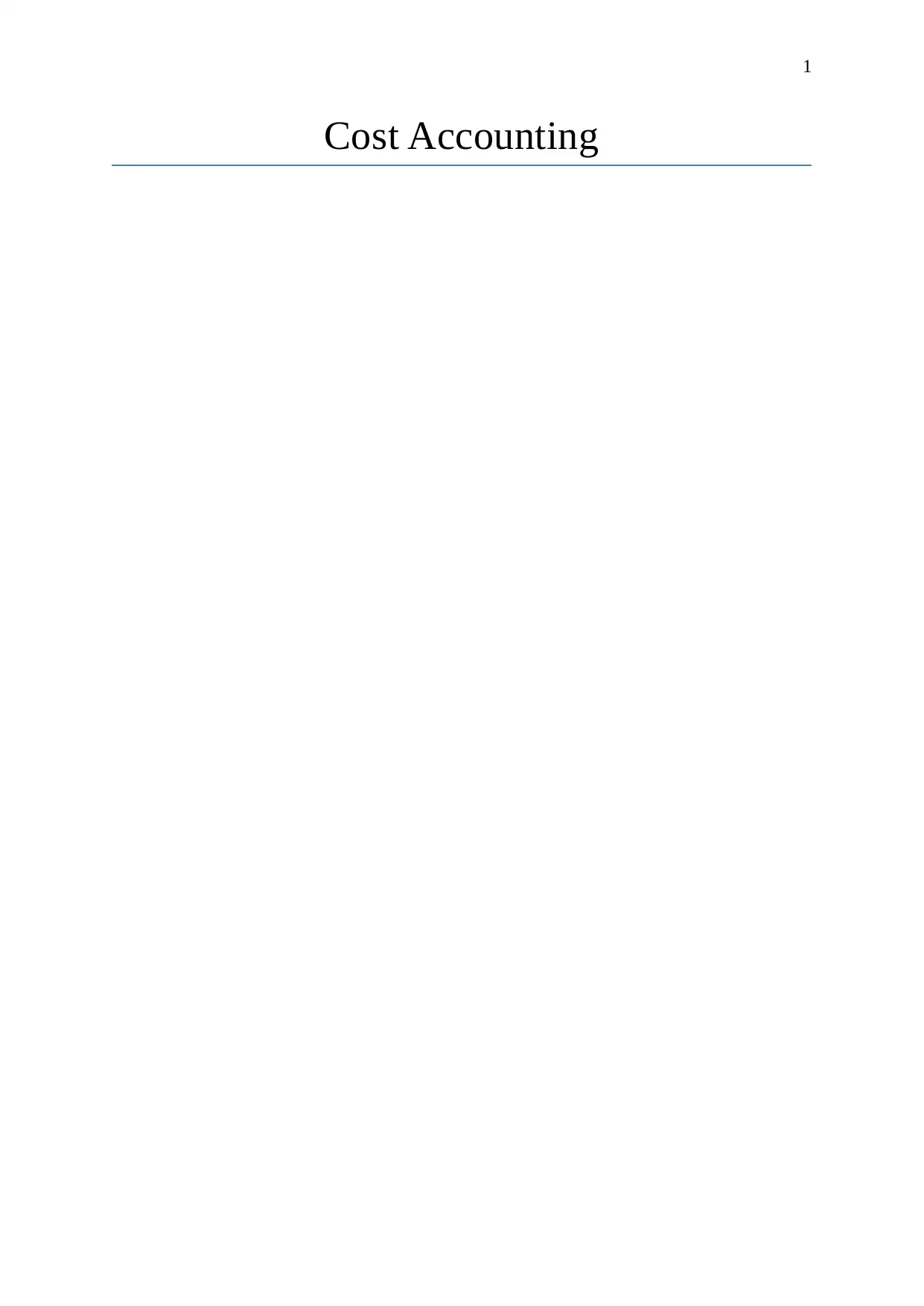
1
Cost Accounting
Cost Accounting
Paraphrase This Document
Need a fresh take? Get an instant paraphrase of this document with our AI Paraphraser
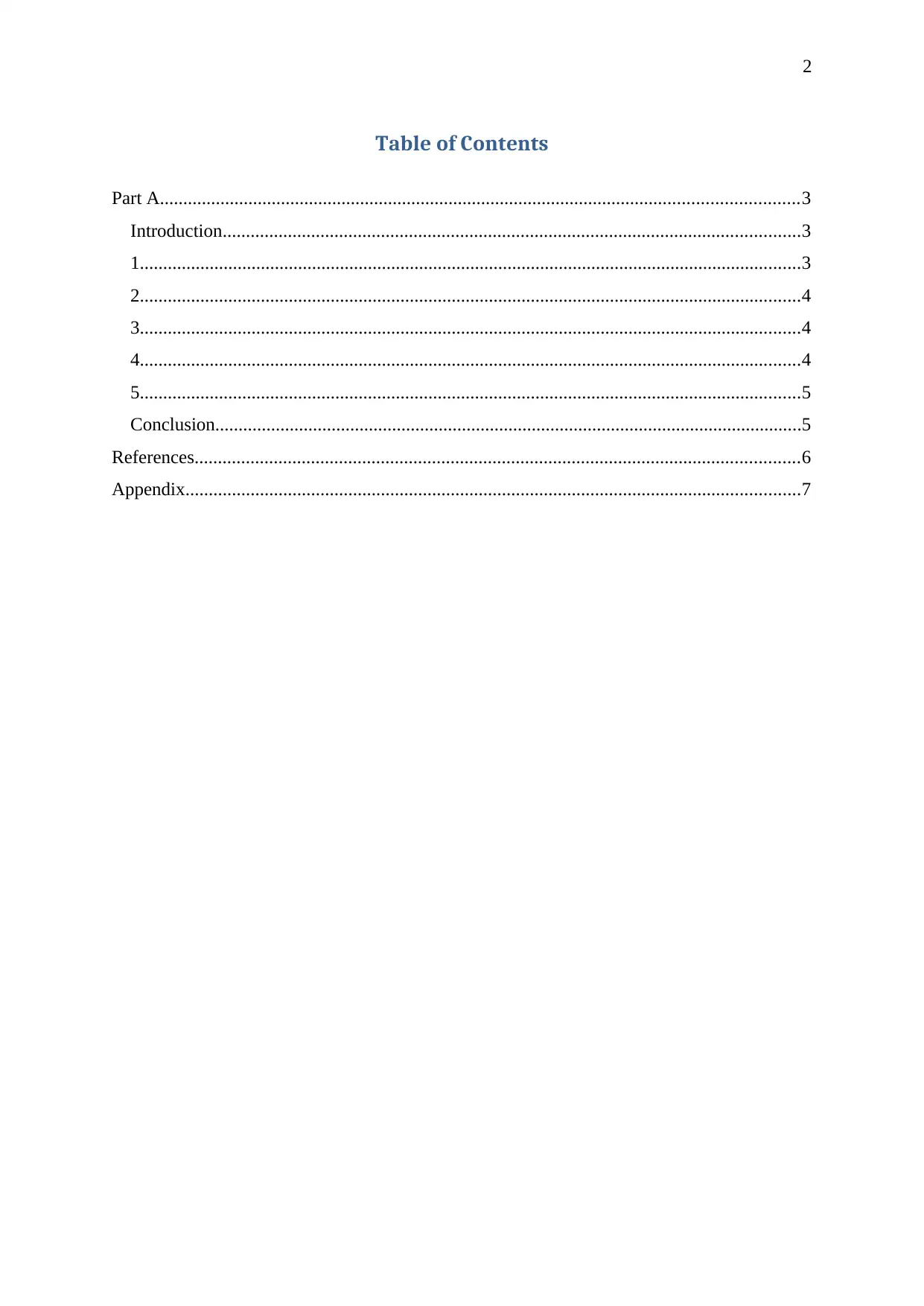
2
Table of Contents
Part A.........................................................................................................................................3
Introduction............................................................................................................................3
1..............................................................................................................................................3
2..............................................................................................................................................4
3..............................................................................................................................................4
4..............................................................................................................................................4
5..............................................................................................................................................5
Conclusion..............................................................................................................................5
References..................................................................................................................................6
Appendix....................................................................................................................................7
Table of Contents
Part A.........................................................................................................................................3
Introduction............................................................................................................................3
1..............................................................................................................................................3
2..............................................................................................................................................4
3..............................................................................................................................................4
4..............................................................................................................................................4
5..............................................................................................................................................5
Conclusion..............................................................................................................................5
References..................................................................................................................................6
Appendix....................................................................................................................................7
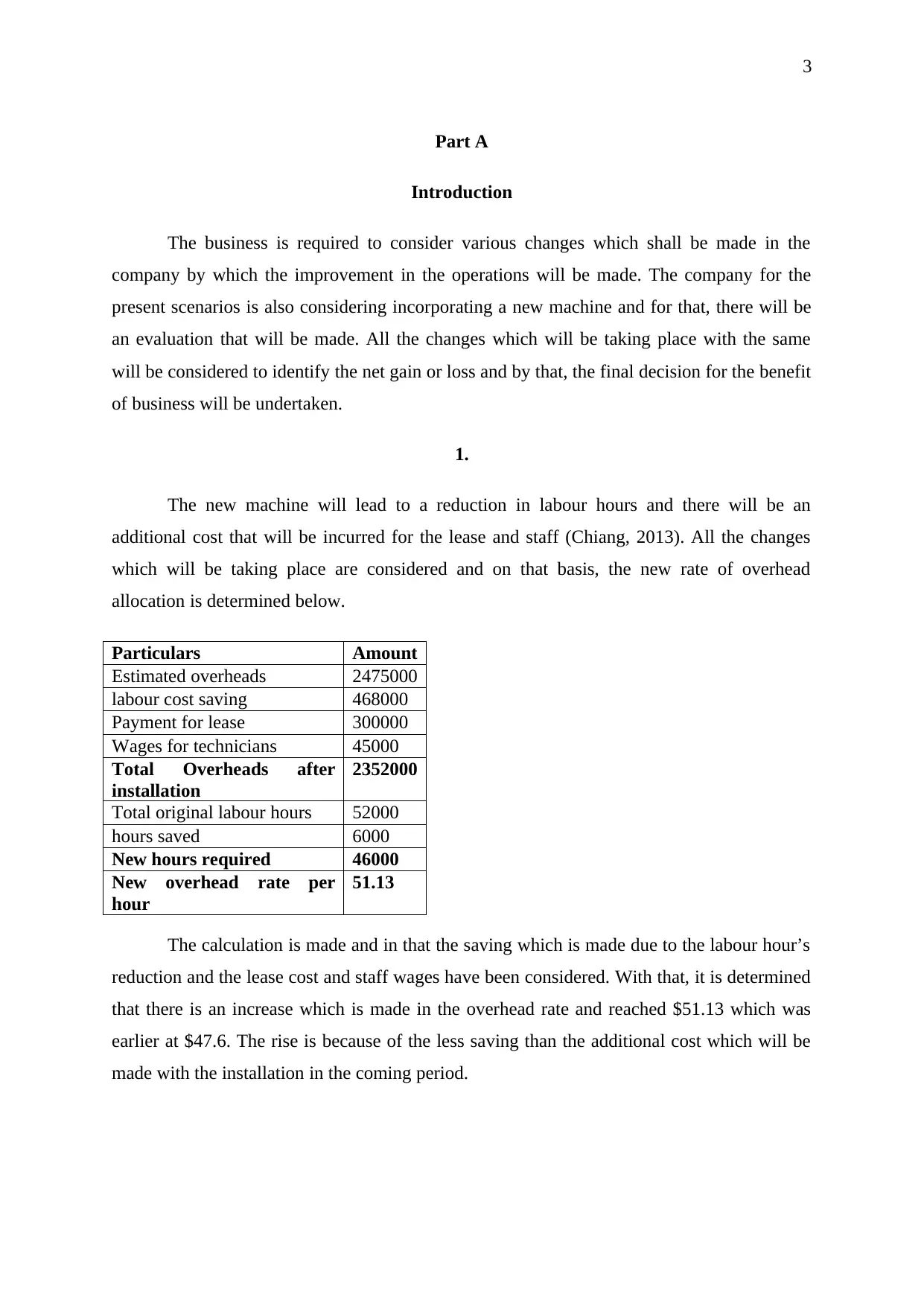
3
Part A
Introduction
The business is required to consider various changes which shall be made in the
company by which the improvement in the operations will be made. The company for the
present scenarios is also considering incorporating a new machine and for that, there will be
an evaluation that will be made. All the changes which will be taking place with the same
will be considered to identify the net gain or loss and by that, the final decision for the benefit
of business will be undertaken.
1.
The new machine will lead to a reduction in labour hours and there will be an
additional cost that will be incurred for the lease and staff (Chiang, 2013). All the changes
which will be taking place are considered and on that basis, the new rate of overhead
allocation is determined below.
Particulars Amount
Estimated overheads 2475000
labour cost saving 468000
Payment for lease 300000
Wages for technicians 45000
Total Overheads after
installation
2352000
Total original labour hours 52000
hours saved 6000
New hours required 46000
New overhead rate per
hour
51.13
The calculation is made and in that the saving which is made due to the labour hour’s
reduction and the lease cost and staff wages have been considered. With that, it is determined
that there is an increase which is made in the overhead rate and reached $51.13 which was
earlier at $47.6. The rise is because of the less saving than the additional cost which will be
made with the installation in the coming period.
Part A
Introduction
The business is required to consider various changes which shall be made in the
company by which the improvement in the operations will be made. The company for the
present scenarios is also considering incorporating a new machine and for that, there will be
an evaluation that will be made. All the changes which will be taking place with the same
will be considered to identify the net gain or loss and by that, the final decision for the benefit
of business will be undertaken.
1.
The new machine will lead to a reduction in labour hours and there will be an
additional cost that will be incurred for the lease and staff (Chiang, 2013). All the changes
which will be taking place are considered and on that basis, the new rate of overhead
allocation is determined below.
Particulars Amount
Estimated overheads 2475000
labour cost saving 468000
Payment for lease 300000
Wages for technicians 45000
Total Overheads after
installation
2352000
Total original labour hours 52000
hours saved 6000
New hours required 46000
New overhead rate per
hour
51.13
The calculation is made and in that the saving which is made due to the labour hour’s
reduction and the lease cost and staff wages have been considered. With that, it is determined
that there is an increase which is made in the overhead rate and reached $51.13 which was
earlier at $47.6. The rise is because of the less saving than the additional cost which will be
made with the installation in the coming period.
⊘ This is a preview!⊘
Do you want full access?
Subscribe today to unlock all pages.

Trusted by 1+ million students worldwide
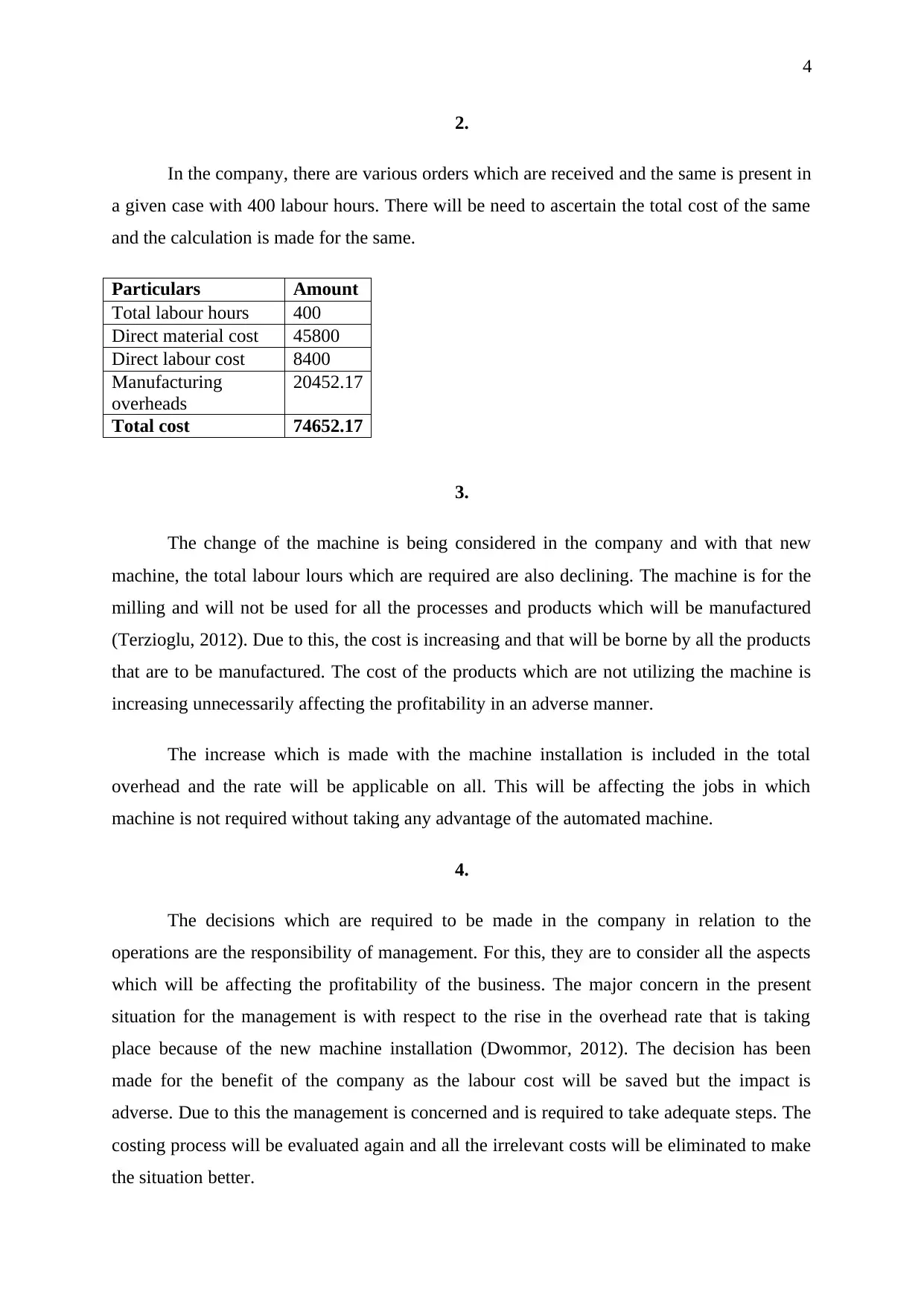
4
2.
In the company, there are various orders which are received and the same is present in
a given case with 400 labour hours. There will be need to ascertain the total cost of the same
and the calculation is made for the same.
Particulars Amount
Total labour hours 400
Direct material cost 45800
Direct labour cost 8400
Manufacturing
overheads
20452.17
Total cost 74652.17
3.
The change of the machine is being considered in the company and with that new
machine, the total labour lours which are required are also declining. The machine is for the
milling and will not be used for all the processes and products which will be manufactured
(Terzioglu, 2012). Due to this, the cost is increasing and that will be borne by all the products
that are to be manufactured. The cost of the products which are not utilizing the machine is
increasing unnecessarily affecting the profitability in an adverse manner.
The increase which is made with the machine installation is included in the total
overhead and the rate will be applicable on all. This will be affecting the jobs in which
machine is not required without taking any advantage of the automated machine.
4.
The decisions which are required to be made in the company in relation to the
operations are the responsibility of management. For this, they are to consider all the aspects
which will be affecting the profitability of the business. The major concern in the present
situation for the management is with respect to the rise in the overhead rate that is taking
place because of the new machine installation (Dwommor, 2012). The decision has been
made for the benefit of the company as the labour cost will be saved but the impact is
adverse. Due to this the management is concerned and is required to take adequate steps. The
costing process will be evaluated again and all the irrelevant costs will be eliminated to make
the situation better.
2.
In the company, there are various orders which are received and the same is present in
a given case with 400 labour hours. There will be need to ascertain the total cost of the same
and the calculation is made for the same.
Particulars Amount
Total labour hours 400
Direct material cost 45800
Direct labour cost 8400
Manufacturing
overheads
20452.17
Total cost 74652.17
3.
The change of the machine is being considered in the company and with that new
machine, the total labour lours which are required are also declining. The machine is for the
milling and will not be used for all the processes and products which will be manufactured
(Terzioglu, 2012). Due to this, the cost is increasing and that will be borne by all the products
that are to be manufactured. The cost of the products which are not utilizing the machine is
increasing unnecessarily affecting the profitability in an adverse manner.
The increase which is made with the machine installation is included in the total
overhead and the rate will be applicable on all. This will be affecting the jobs in which
machine is not required without taking any advantage of the automated machine.
4.
The decisions which are required to be made in the company in relation to the
operations are the responsibility of management. For this, they are to consider all the aspects
which will be affecting the profitability of the business. The major concern in the present
situation for the management is with respect to the rise in the overhead rate that is taking
place because of the new machine installation (Dwommor, 2012). The decision has been
made for the benefit of the company as the labour cost will be saved but the impact is
adverse. Due to this the management is concerned and is required to take adequate steps. The
costing process will be evaluated again and all the irrelevant costs will be eliminated to make
the situation better.
Paraphrase This Document
Need a fresh take? Get an instant paraphrase of this document with our AI Paraphraser
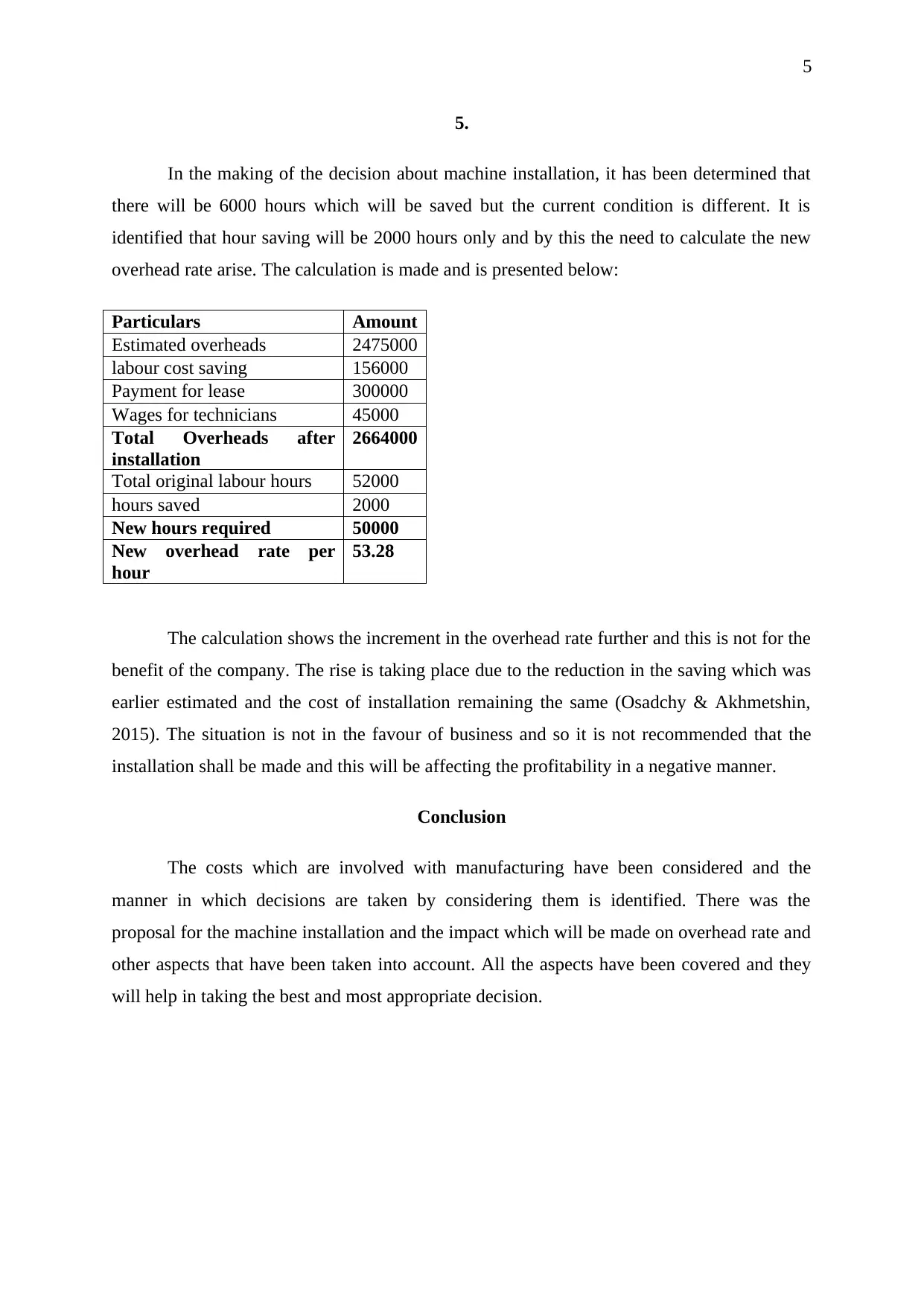
5
5.
In the making of the decision about machine installation, it has been determined that
there will be 6000 hours which will be saved but the current condition is different. It is
identified that hour saving will be 2000 hours only and by this the need to calculate the new
overhead rate arise. The calculation is made and is presented below:
Particulars Amount
Estimated overheads 2475000
labour cost saving 156000
Payment for lease 300000
Wages for technicians 45000
Total Overheads after
installation
2664000
Total original labour hours 52000
hours saved 2000
New hours required 50000
New overhead rate per
hour
53.28
The calculation shows the increment in the overhead rate further and this is not for the
benefit of the company. The rise is taking place due to the reduction in the saving which was
earlier estimated and the cost of installation remaining the same (Osadchy & Akhmetshin,
2015). The situation is not in the favour of business and so it is not recommended that the
installation shall be made and this will be affecting the profitability in a negative manner.
Conclusion
The costs which are involved with manufacturing have been considered and the
manner in which decisions are taken by considering them is identified. There was the
proposal for the machine installation and the impact which will be made on overhead rate and
other aspects that have been taken into account. All the aspects have been covered and they
will help in taking the best and most appropriate decision.
5.
In the making of the decision about machine installation, it has been determined that
there will be 6000 hours which will be saved but the current condition is different. It is
identified that hour saving will be 2000 hours only and by this the need to calculate the new
overhead rate arise. The calculation is made and is presented below:
Particulars Amount
Estimated overheads 2475000
labour cost saving 156000
Payment for lease 300000
Wages for technicians 45000
Total Overheads after
installation
2664000
Total original labour hours 52000
hours saved 2000
New hours required 50000
New overhead rate per
hour
53.28
The calculation shows the increment in the overhead rate further and this is not for the
benefit of the company. The rise is taking place due to the reduction in the saving which was
earlier estimated and the cost of installation remaining the same (Osadchy & Akhmetshin,
2015). The situation is not in the favour of business and so it is not recommended that the
installation shall be made and this will be affecting the profitability in a negative manner.
Conclusion
The costs which are involved with manufacturing have been considered and the
manner in which decisions are taken by considering them is identified. There was the
proposal for the machine installation and the impact which will be made on overhead rate and
other aspects that have been taken into account. All the aspects have been covered and they
will help in taking the best and most appropriate decision.
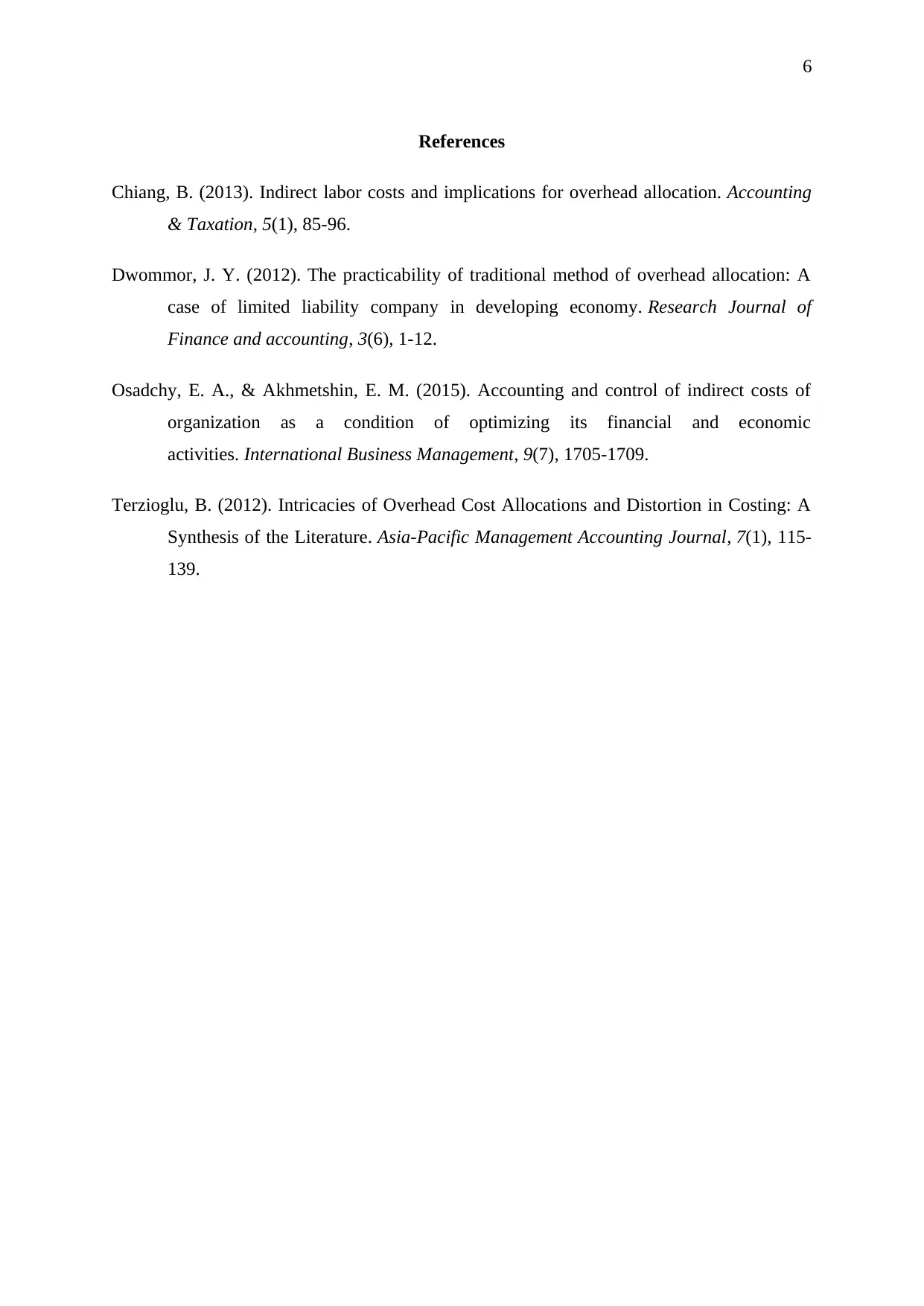
6
References
Chiang, B. (2013). Indirect labor costs and implications for overhead allocation. Accounting
& Taxation, 5(1), 85-96.
Dwommor, J. Y. (2012). The practicability of traditional method of overhead allocation: A
case of limited liability company in developing economy. Research Journal of
Finance and accounting, 3(6), 1-12.
Osadchy, E. A., & Akhmetshin, E. M. (2015). Accounting and control of indirect costs of
organization as a condition of optimizing its financial and economic
activities. International Business Management, 9(7), 1705-1709.
Terzioglu, B. (2012). Intricacies of Overhead Cost Allocations and Distortion in Costing: A
Synthesis of the Literature. Asia-Pacific Management Accounting Journal, 7(1), 115-
139.
References
Chiang, B. (2013). Indirect labor costs and implications for overhead allocation. Accounting
& Taxation, 5(1), 85-96.
Dwommor, J. Y. (2012). The practicability of traditional method of overhead allocation: A
case of limited liability company in developing economy. Research Journal of
Finance and accounting, 3(6), 1-12.
Osadchy, E. A., & Akhmetshin, E. M. (2015). Accounting and control of indirect costs of
organization as a condition of optimizing its financial and economic
activities. International Business Management, 9(7), 1705-1709.
Terzioglu, B. (2012). Intricacies of Overhead Cost Allocations and Distortion in Costing: A
Synthesis of the Literature. Asia-Pacific Management Accounting Journal, 7(1), 115-
139.
⊘ This is a preview!⊘
Do you want full access?
Subscribe today to unlock all pages.

Trusted by 1+ million students worldwide

7
Appendix
Appendix
Paraphrase This Document
Need a fresh take? Get an instant paraphrase of this document with our AI Paraphraser

8
1 out of 8
Related Documents
Your All-in-One AI-Powered Toolkit for Academic Success.
+13062052269
info@desklib.com
Available 24*7 on WhatsApp / Email
![[object Object]](/_next/static/media/star-bottom.7253800d.svg)
Unlock your academic potential
Copyright © 2020–2025 A2Z Services. All Rights Reserved. Developed and managed by ZUCOL.





